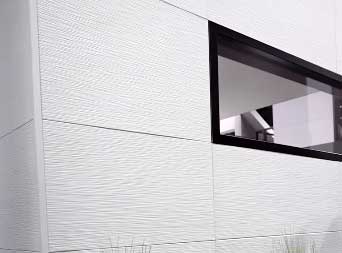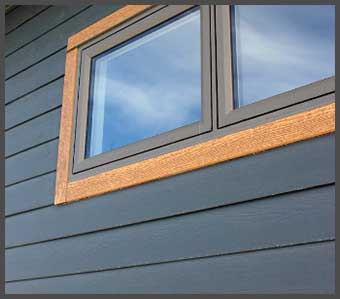When it comes to exterior siding, Hardie board is one of the most popular options for many homeowners.
Hardy board, also known as fiber cement siding, provides the look of wood, stone or brick while offering increased durability and resistance to rot, fire, and termites. Two of the most common texture options for Hardie board siding are smooth and cedarmill.
So what is the difference and which is better for your home?
A Brief Comparison Table
| Feature | Smooth Hardie Board | Cedarmill Hardie Board |
| Appearance | Flat, even surface like stucco | Textured vertical grain to mimic wood |
| Cost | Less expensive | $1+ more per square foot |
| Maintenance | Shows scuffs but easy to clean | Texture hides imperfections |
| Durability | 30 year warranty | 30 year warranty |
| Design Styles | Contemporary, modern | Traditional, farmhouse, cottage |
| Installation | No difference in weight or handling | No difference in weight or handling |
| Climate Considerations | Scuffs show more in wet climates | Disguises moisture damage |
| Combination Options | Pairs well with other textures | Can mix direction for interest |
What is Hardie Board Siding?
Before diving into the differences between smooth and cedarmill, let’s start with an overview of what exactly Hardie board siding is. Hardie board siding is made from a mixture of cement, sand, and cellulose fibers.

The cement makes it more durable while the cellulose fibers provide flexibility to avoid cracking.
Unlike vinyl or aluminum siding, Hardie board can last over 50 years and comes with up to a 30 year manufacturer warranty.
It provides excellent protection from the elements while still offering design flexibility with different styles and textures.
Hardie board is also fireproof and resists rot and termites.
While more expensive upfront than some other siding options, Hardie board is a smart long-term investment for many homeowners. Over the lifetime of your home, you’ll avoid the maintenance, repairs, and replacements required with other sidings.
Key Differences Between Smooth and Cedarmill Hardie Board
So when it comes to choosing between smooth or cedarmill texture for Hardie board siding, what are the key differences? Here’s an overview:
- Appearance: The main difference is the visible texture. Smooth Hardie board has a flat, even surface like stucco or masonry. Cedarmill has a lightly textured, vertical striated pattern designed to mimic the look of real wood siding.
- Maintenance: Smooth Hardie board will show dirt and scuffs more easily since it has a uniform appearance. The lightly variegated texture of cedarmill helps disguise any marks and imperfections better. However, both are low maintenance compared to real wood or other sidings.
- Cost: Smooth Hardie boards are typically a bit less expensive than cedarmill texture. Though pricing also depends on your contractor’s labor costs for installation.
- Durability: Both smooth and cedarmill Hardie board are equally durable and come with the same warranties from the manufacturer. The texture itself does not impact the longevity or performance.
- Flexibility: You can combine both smooth and cedarmill Hardie boards together on different parts of your home exterior for more design flexibility. Mixing vertical, horizontal, and diagonal cedarmill textures can also create visual interest.
Now that we’ve covered the key differences, let’s dive deeper into the pros and cons of each option.
Pros and Cons of Smooth Hardie Board Siding
Here are the main benefits that make smooth Hardie board siding a popular choice:
- Sleek, modern appearance: The flat smooth surface gives a contemporary stucco-like look. It creates a minimalistic, streamlined aesthetic for both traditional and modern home designs.
- Versatile pairing options: Smooth Hardie board can be easily combined with trim, battens, and accent siding in different colors or textures. This allows for lots of customization.
- Low maintenance: Without the striated wood grain pattern, smooth Hardie board won’t show dirt or scuffs as readily. It can be easily cleaned with gentle pressure washing.
- Fireproof and rot resistant: Like all fiber cement sidings, smooth Hardie board is non-combustible and resists moisture damage or rotting like real wood can.
- Durable and long-lasting: Backed by a 30 year manufacturer warranty, smooth Hardie board stands up to weather, wind, rain, and hail over decades of use.
- Sets off landscaping: The simple uniform surface puts more emphasis on gardens, stonework, pathways, and other exterior design elements.
Some potential downsides to consider include:
- Higher cost than vinyl: Smooth fiber cement Hardie board costs more upfront than alternative sidings like vinyl or aluminum. But it also lasts much longer.
- Heavier to work with: At around 1.25 pounds per square foot, smooth Hardie board is heavier and more difficult to cut and install than other sidings. This may increase your installation costs.
- Not as realistic as wood: While attractive, the appearance is not as natural looking as real wood grain. For some homeowners, this sleekness is a pro rather than a con.
- Prone to cracks if not installed properly: Correct fastening, caulking, and spacing is important during installation to prevent cracking around openings or joints.
- Can show imperfections: Without a textured grain, any minor scrapes, unevenness, or cracks will be more visible on the smooth flat surface.
Pros and Cons of Cedarmill Hardie Board Siding
Now let’s examine the key advantages and potential drawbacks of using cedarmill textured Hardie board siding:

- Realistic wood look: The textured vertical grain pattern mimics the look of real cedar siding. This natural appearance is ideal for Craftsman, farmhouse, or cottage styles.
- Hides imperfections: The textured wood grain helps disguise any minor scratches, scrapes or uneven areas in the siding surface.
- Design versatility: Cedarmill texture can be installed vertically, horizontally, or diagonally based on your preference. Mixing directions adds further visual interest.
- Ideal for remodeling: Provides an affordable and durable wood siding replacement. Mimics the look of original cedar wood siding on older homes.
- Fire, rot, and insect resistant: Cedarmill fiber cement has all the same protective qualities against fire, moisture, termites and more.
- Long warranty: Like smooth Hardie board, the cedarmill texture option comes with a 30 year limited product warranty.
- Easy to clean: The textured pattern on cedarmill Hardie board camouflages dirt or debris. It can be easily cleaned just like smooth siding.
Some of the potential cons of cedarmill Hardie board siding include:
- More expensive than smooth Hardie board: Cedarmill costs $1 or more per square foot extra over smooth, since it requires additional manufacturing steps.
- Heavier to install: At around 1.25 pounds per square foot, cedarmill weighs the same as smooth. The texture makes it no heavier or lighter.
- Still pricier than other sidings: Cedarmill Hardie board costs more upfront compared to basic vinyl, aluminum or real cedar wood siding options.
- Looks less modern: The obvious wood grain texture has a more traditional, natural look compared to sleek smooth fiber cement.
- Vulnerable around openings: Just like smooth siding, proper installation practices are key to prevent cracks at corners or around windows.
Which Is Better?
So when choosing your home’s siding, should you go with smooth or cedarmill Hardie board? Here are some key factors to help you decide:
- Home design and style: What overall look are you going for? Smooth has a modern stucco appearance, while cedarmill looks more like real wood siding.
- Budget: Initially cedarmill costs $1 or more extra per square foot compared to smooth Hardie board. Get quotes from local siding contractors.
- Combining textures: Many homeowners use both for visual interest. An exterior could have smooth siding on most of the façade with a cedarmill accent wall.
- Ease of installation: Neither smooth nor cedarmill is necessarily easier or harder to install. The textured surface makes no difference to the weight or handling.
- Local climate: In very wet or humid climates, the wood grain texture can help disguise any mold, mildew, or algae growth over time.
- Mixing siding materials: Often fiber cement Hardie board is combined with shakes, shingles, stone, or stucco. The texture contrasts create appealing combinations.
- Grain direction: Decide if you want vertical, horizontal, or diagonal grain. Customizing direction can add design interest on different parts of your home’s exterior.
Frequently Asked Questions (FAQ)
The main difference is the surface appearance. Smooth Hardie planks have a uniform, flat surface like stucco. Cedarmill Hardie planks have a textured wood grain pattern designed to mimic the look of real cedar board siding.
Cedarmill Hardie siding is used to recreate the appearance of wood siding on the exterior of homes and buildings. Its textured pattern looks like real cedar wood grain. It provides a natural wood aesthetic while offering the benefits of durable fiber cement.
Smooth Hardie board has a flat, even surface with no texture or wood grain pattern. Rough Hardie board is textured to mimic wood grain like cedarmill. While smooth has a more modern stucco look, rough Hardie board looks more natural like real cedar siding.
Yes, smooth Hardie board siding is one of the most common options. It has an even, uniform appearance without any textured wood grain. Smooth Hardie board provides a sleek, contemporary aesthetic popular in modern architectural styles.
Final Thoughts
While smooth and cedarmill have their pros and cons, both offer the durability, longevity and low maintenance that makes Hardie board siding so popular.
Carefully weighing your priorities will help determine whether one texture or the other is the better match for your specific home.
